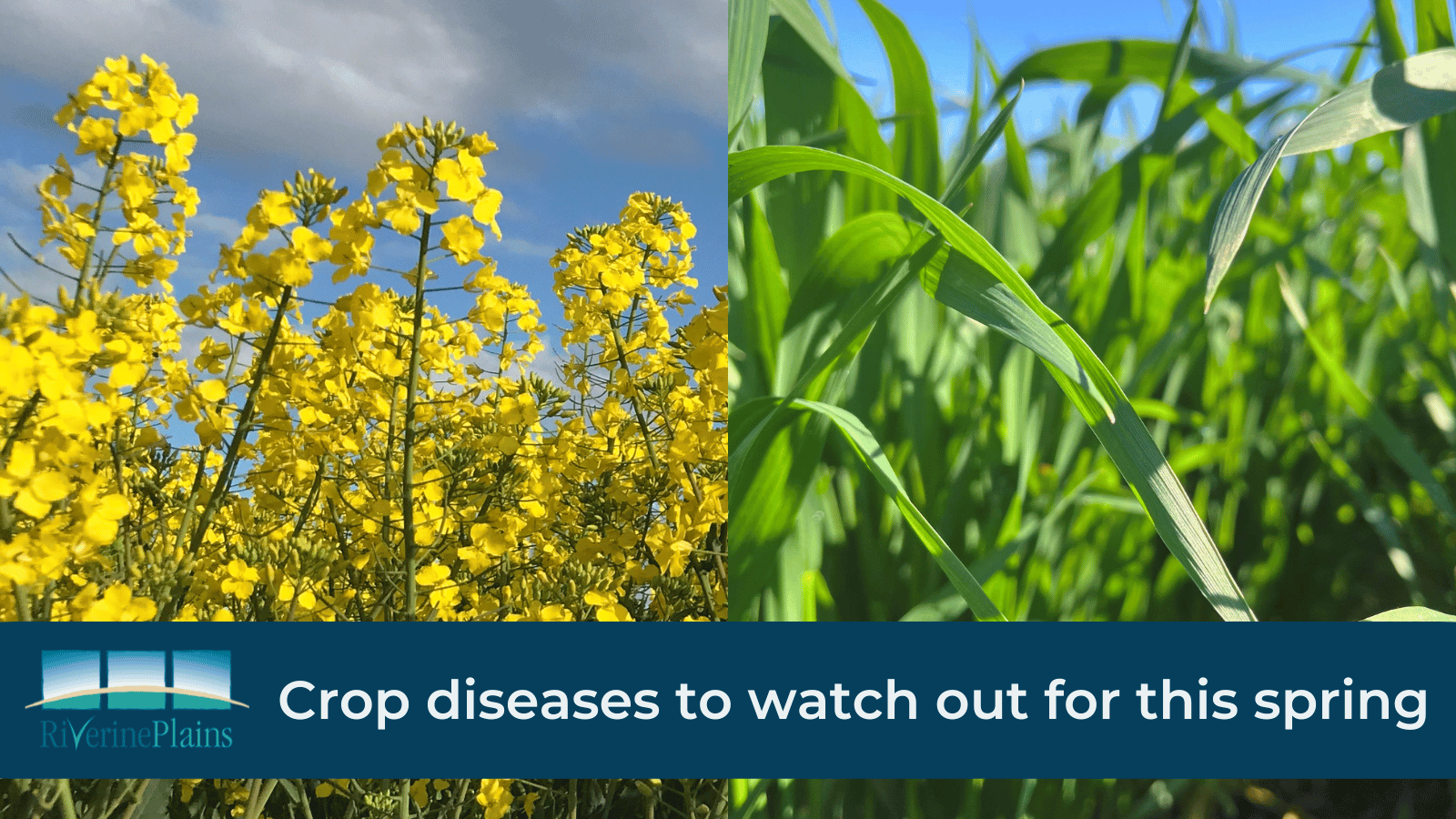Crop diseases to watch out for this spring

Key messages
- monitor now for fungal diseases including stripe rust, septoria and sclerotinia
- despite predictions for a drier-than-average spring, disease outbreaks could still occur
- rotate fungicide groups to reduce the risk of resistance developing and investigate the potential of new fungicide products
Despite predictions of a drier than average finish for 2023, fungal diseases could still be a problem across the Riverine Plains this spring. The last few wet seasons have resulted in high background levels of disease; this combined with the popularity of susceptible varieties means it won’t take much moisture to see disease potentially progress during late winter and spring.
Last year was an exceptionally high-pressure year for disease. While there certainly isn’t the same level of early infection this season, there is still plenty of disease about. As such, it’s important that growers monitor their crops now for disease to prevent potential outbreaks and crop losses later in the season.
Three to watch: stripe rust, septoria, sclerotinia
Stripe rust is a particular concern in cereals given the popularity of stripe rust-susceptible wheat varieties being grown in the region and the severe and early infections seen last year.
In early July (2023), stripe rust was confirmed at Jindera and has since been found at other locations across NSW, Victoria, Tasmania and South Australia. This first detection is around two weeks earlier than the long-term eastern Australian average, but about seven weeks later than last year’s severe outbreak.
Although the later onset of stripe rust this year compared to last year should mean less disease pressure, the widespread geographic distribution provides potential for rapid disease build-up if conditions in the coming months are favourable. Stripe rust only requires high humidity for four to six hours at 10 –15°C to cause infection.
If you detect stripe rust in your crop, consult with your agronomist regarding the most economic application timing and product for your crop situation.
The Australian Cereal Rust survey monitors rust strains; if you notice rust in crops previously thought resistant, please click here for further information on how to collect and submit samples.
Septoria tritici blotch (STB) has also become increasingly common in the Riverine Plains, thanks to increased stubble retention, the use of susceptible cultivars and favourable conditions over the past few seasons.
STB survives between seasons on wheat stubble, with rain or heavy dew in autumn and early winter causing spores to be released. These early spore releases cause blotches to form on the lower leaves of wheat plants, which then produce a second type of fruiting body (pycnidia). When the leaf surface is wet, the pycnidia ooze spores which then splash to other leaves, causing new infections. Because rain splash is the key to infection, a wet spring will be more conducive to STB build up than a dry season.
STB can seem to appear from nowhere — one day the crop seems clean, the next day it’s everywhere — so it’s important to monitor wheat crops now for signs of infection. This especially so in wheat-on-wheat situations, or where stubble from previous seasons is still present. If pycnidia are present on lower leaves, consider starting your fungicide program earlier (GS32) rather than waiting until flag leaf emergence (GS39).
STB is prone to developing resistance, with resistance to some Group 3 fungicides already detected in Victoria. As such, growers should pay careful attention to fungicide strategies and use an integrated approach to management.
*As part of the GRDC and FAR Australia Hyper Yelding Crops trial, Riverine Plains has established two paddock trials of a new fungicide Telbek® Adavelt®, which can be used for the control of Septoria. Results will be available later this season.
Sclerotinia. Once infected, a canola crop can’t be cured of sclerotinia, so the only post-sowing control option is to apply a preventative fungicide at 20 – 30% bloom (15-20 flowers off the main stem, generally 10 – 14 days after flowering starts).
Sclerotinia needs a very specific set of environmental conditions to develop. These include;
- continuous wet conditions for at least 10 days at the soil surface in mid to late winter, with temperatures of 11 – 15°C to germinate soil sclerotia and trigger spore release, and;
- an extended wet period during flowering to cause petal infection, and;
- an extended wet period during petal drop (48 hours at 95% humidity, or more), as well as temperatures of 15 – 25°C, for infected petals to infect the stem
Given background levels across the region are high after a succession of wet seasons, most canola growers won’t chance an infection event and will currently be looking to apply their first preventative spray, if they haven’t already.
If conditions become conducive to disease progression later in the season, a second spray may be needed when first-spray protection wanes.
Choose your fungicides wisely
Resistance to fungicides can build quickly, so it’s important to always rotate your fungicide mode of action and avoid successive use of the same group. Remember that fungicide treated seed (i.e. Systiva®) counts towards your seasonal fungicide use, so check with your agronomist to make sure that this doesn’t conflict with your choice of fungicide for the first foliar spray.
There are also a number of new products coming on the market each year, with improved control compared to older products. While a good quality or newer fungicide may be more expensive, they may offer other benefits (longer control, greater application windows or other features) which may be worth considering.
Summary
Monitor crops for signs of disease infection now and consult your agronomist to determine the right fungicide strategy for your situation.
Further resources and reading
- Septoria (Agriculture Victoria)
- Endemic cereal diseases
- identification and management of field crop diseases in victoria
- FAR Australia’s summary of fungicide timings as part of the Hyper Yielding Crops Project; https://www.youtube.com/watch?v=vOgh2pt4GpY
- Stripe rust in wheat (NSW DPI)
- Managing sclerotinia in canola in 2023 (GRDC)
- GRDC factsheet - sclerotinia (GRDC)


